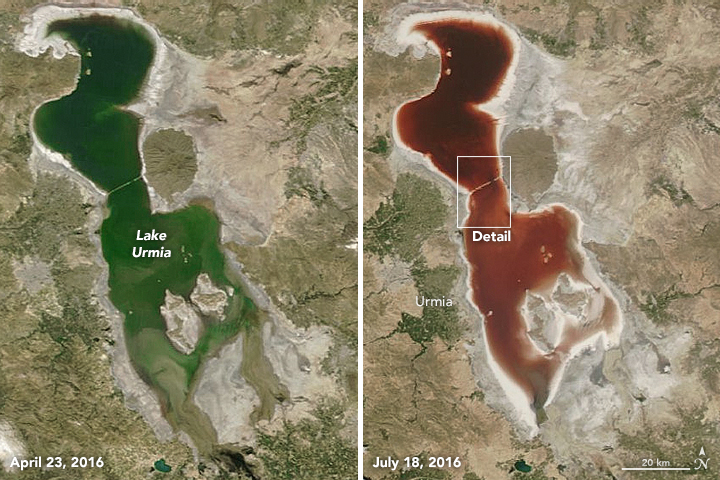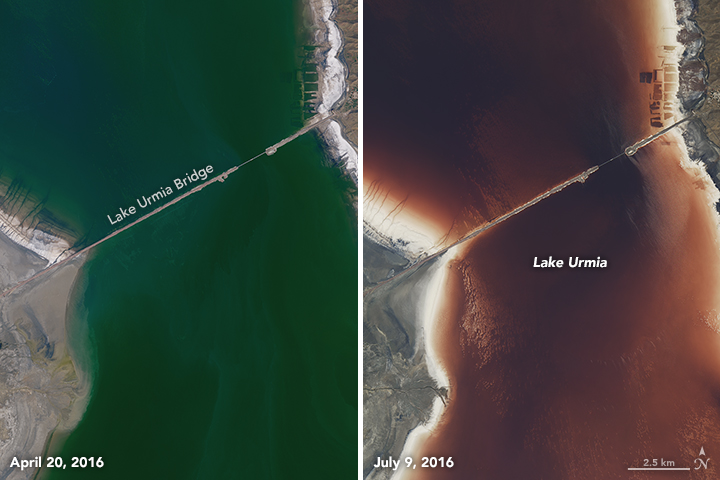


Like the Aral Sea, Iran’s salty Lake Urmia has shrunk rapidly during the past few decades. As it grows smaller, the lake grows saltier. And as it grows saltier, microscopic organisms are periodically turning the water striking shades of red and orange.
The Moderate Resolution Imaging Spectroradiometer (MODIS) on NASA’s Aqua satellite recently captured a transition in the color of Lake Urmia between April and July 2016. On April 23, (left image) the water was green; by July 18, it was the color of wine. The shoreline is encrusted with salt deposits and appears white. Note that the ring of salt is especially noticeable in July, when water levels were lower.
The color changes have become common in the spring and early summer due to seasonal precipitation and climate patterns. Spring is the wettest season in northwestern Iran, with rainfall usually peaking in April. Snow on nearby mountains within the watershed also melts in the spring. The combination of rain and snowmelt sends a surge of fresh water into Lake Urmia in April and May. By July, the influx of fresh water has tapered off and lake levels begin to drop.
The fresh water in the spring drives salinity levels down, but the lake generally becomes saltier as summer heat and dryness take hold. That’s when the microorganisms show their colors, too. Careful sampling of the water would be required to determine which organisms transformed the lake in 2016, but scientists say there are likely two main groups of organisms involved: a family of algae called Dunaliella and an archaic family of bacteria known as Halobacteriaceae.
“Previous research suggests that Dunaliella salina is responsible for reddening of Lake Urmia,” explained Mohammad Tourian, a scientist at the University of Stuttgart. “In the marine environment, Dunaliella salina appears green; however, in conditions of high salinity and light intensity, the microalgae turns red due to the production of protective carotenoids in the cells.”

Other scientists emphasize the role of Halobacteriaceae, a group of bacteria found in water that is saturated or nearly saturated with salt. These bacteria release a red pigment called bacteriorhodopsin that absorbs light and converts it into energy for the bacteria. When populations of the bacteria are large enough, they can stain bodies of water.
Note that in July 2016, the color of the lake (and thus salinity levels) appeared to be relatively constant, despite the presence of a highway causeway. While there has been concern that the causeway would make it difficult for water to circulate between the northern and southern arms of the lake—as is the case in the Great Salt Lake of Utah—the effect in Lake Urmia is not nearly as noticeable. The images below, captured by the by the Operational Land Imager (OLI) on Landsat 8 on April 20 and July 9, 2016, show part of the causeway before and after the lake’s color changed.
While Lake Urmia has shifted from green to red and back several times in recent years, trends suggest that a red Urmia could become increasingly common. Drought and intensive water diversion for agriculture has been limiting the amount of fresh water reaching the lake. “The lake volume has been decreasing at an alarming rate of 1.03 cubic kilometers per year,” noted Tourian, who recently analyzed data from several satellites to track how Urmia has changed. “The results from satellite imagery revealed a loss of water extent at an average rate of 220 square kilometers per year, which indicates that the lake has lost about 70 percent of its surface area over the last 14 years.”
NASA Earth Observatory images by Joshua Stevens, using MODIS data from the Land Atmosphere Near real-time Capability for EOS (LANCE) and Landsat data from the U.S. Geological Survey. Caption by Adam Voiland, with information from Amin Eimanifar (University of Florida) and Mohammed Tourian (University of Stuttgart).